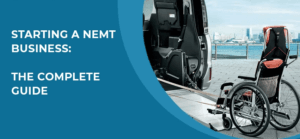Introduction
The non-emergency medical transportation (NEMT) industry is vital in providing safe and comfortable transportation for individuals who require medical attention but don’t need emergency services. If you’ve been considering launching your own NEMT business, you’re in the right place! This step-by-step guide will walk you through the entire process, from market research to purchasing your first vehicle.
Starting a Non-Emergency Medical Transportation Business Guideline

1. Market Research and Business Planning
In the rapidly growing non-emergency medical transportation (NEMT) field, understanding your market is the cornerstone of success. Market research in the NEMT industry is not just about identifying opportunities; it’s about aligning your business with the community’s needs
a. Understand Your Market
- Identify the target audience.
- Analyze competition in your area.
- Assess local needs and gaps in service
b. Create a Business Plan
- Define your business mission and goals
- Obtain necessary business licenses in your state and local county
- Apply for an Employer Identification Number (EIN) through the free IRS website.
c. Register Your Business
- Incorporate your business with the state.
- Obtain necessary business licenses in your state and local county.
- Apply for an Employer Identification Number (EIN) through the free IRS website.
2. Certification and Compliance
Certification and compliance are the backbones of a successful non-emergency medical transportation (NEMT) business. They ensure the legal operation of your business and foster trust and credibility among clients and healthcare partners.
a. Contact the Local Health or Medicaid Office
- Apply for provider certification.
- Ensure compliance with local and state regulations.
- Understand the requirements for Medicare and Medicaid Services, if applicable.
3. Vehicle Selection and Accessibility
In the non-emergency medical transportation (NEMT) sector, vehicle selection goes beyond mere convenience; it provides accessible, comfortable, and tailored transportation solutions for individuals with varying medical needs.
a. Avoid Ambulatory Vehicles Only
- Consider vehicles with wheelchair access.
- Investigate regulations regarding accessible transportation in your area.
b. Search for Suitable Vehicles, But Don’t Buy Yet
- Research different vehicle options and costs.
- Identify reliable dealerships or vendors.
- Consider leasing options if applicable.
4. Secure Funding and Purchase Vehicles
When starting a non-emergency medical transportation (NEMT) business, securing the proper funding and making wise vehicle purchases are vital steps in laying a solid foundation. These components not only support the launch of your services but shape the quality and reach of your NEMT offerings.
a. Evaluate Funding Options
- Explore bank loans, grants, or investor opportunities.
- Assess personal financial contributions.
b. Purchase or Lease Vehicles
- Finalize your choice and negotiate the terms.
- Ensure all necessary modifications and equipment are included.
- Obtain appropriate vehicle insurance.
5. Driver Training and Hiring
Hiring well-trained and reliable drivers is essential in establishing your non-emergency medical transportation business. Ensuring that drivers have the proper training, certifications, and background not only keeps your clients safe but also maintains the reputation of your business.
a. CDL Training, if Applicable
- Determine if a Commercial Driver’s License (CDL) is required for the vehicles you’ll be operating.
- Assist potential drivers in obtaining CDL training and certification if needed.
- Consider offering or subsidizing training programs for prospective hires.
b. Defensive Driving
- Require all drivers to complete a defensive driving course.
- Continuously emphasize the importance of safe driving practices.
- Offer periodic refresher courses to maintain skills.
c. DOT Physical
- Ensure drivers pass a Department of Transportation (DOT) physical examination.
- Regularly review and comply with updated DOT physical requirements.
d. Drug Testing
- Implement a drug testing policy following local, state, and federal regulations.
- Consider pre-employment, random, and post-accident drug testing.
e. Background Checks
- Conduct thorough background checks, including criminal and driving history.
- Utilize professional background check services to ensure accuracy and compliance.
f. 3-5 Year Driving Record
- Review and evaluate driving records for all potential drivers for the past 3-5 years.
- Establish clear guidelines and expectations for maintaining a clean driving record.
6. Marketing and Launch
Launching and marketing your non-emergency medical transportation (NEMT) service successfully requires a well-crafted strategy that introduces your business to the community and
positions it as a reliable and essential healthcare service provider.
a. Build Your Brand
- Create a professional website.
- Develop marketing materials like brochures, business cards, and social media presence.
b. Network and Collaborate
- Establish relationships with healthcare providers and local organizations.
- Join industry associations and attend networking events.
Conclusion
Starting a non-emergency medical transportation business can be a rewarding and profitable venture. With careful planning, compliance, and consideration of the unique needs of your target market, you can establish a successful NEMT business. To lay the foundation for a strong NEMT company, don’t hesitate to contact Willena, your dedicated NEMT startup coach. With her expert guidance and industry insights, she can assist in ensuring that your business is well-positioned to provide essential services in your community. Her tailored approach aligns with your specific goals, offering a strategic path to success in medical transportation.

